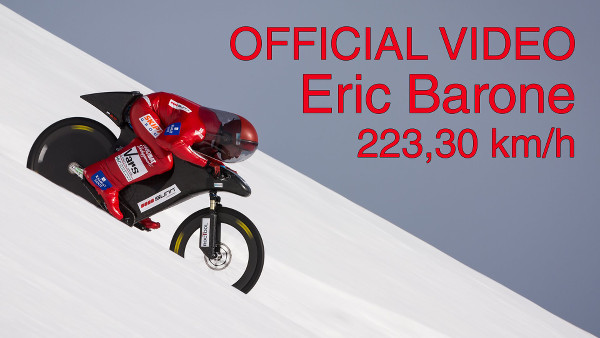
Speedy Downhill
If you want to go fast downhill then you better know your aerodynamics. For an alpine skier and a downhill cyclist, drag is the force holding them back, but with the application of some basic fluid dynamics knowledge they can go faster - a lot faster.
 Eric Barone - 223,30 km/h (138.752 mph) - World mountain bike speed record
Eric Barone - 223,30 km/h (138.752 mph) - World mountain bike speed record
To minimize drag there are a few basic principles that our alpine skier and downhill cyclist need to address.
Cross Sectional Area
Drag is directly proportional to the cross sectional area facing the air flow. For an alpine skier this means maintaining a low tuck position and for a downhill cyclist it means hunching low on the bike, with both trying to align their heads in the shadow of their horizontal torso.
Airfoil Profiles
Air flow around a cylinder typically produces 10 times more drag than that around an airfoil with the same cross sectional area. The skier and cyclist both have cylinder-like legs and arms that would benefit from airfoil (streamlined) fairings. Airfoil shaped ski boots for the skier and airfoil fairings behind the legs and arms for the cyclist would go a long way to minimizing drag.
Helmets are essential for safety, but they also present an opportunity to produce a streamlined shape around the head. Without a helmet the head is essentially a sphere, which is another high drag shape (like a cylinder), so a streamlined helmet would be a real benefit in reducing drag.
Boundary Layer
If you can maintain a laminar boundary layer over the majority of your body (i.e., avoiding turbulent flow) then again drag will be minimized. Given the relatively low (aerodynamic) speeds of skiing and cycling if should be theoretically possible to maintain laminar flow over the streamlined skier and cyclist. However, this is easier said than done and often a laminar boundary layer can be 'tripped' (e.g., by something innocuous as a clothing seam) to become turbulent, thus increasing drag. To maintain laminar flow our ski and cycling suits need to be smooth, especially on the front facing the wind.
On rear facing panels it might be advantageous for drag reduction to encourage turbulent air flow (with a certain amount of rough texture) if the flow is going to separate anyway, using a similar approach to dimples on a golf ball.
Results
How did our alpine skier and downhill cyclist do? Did they miss anything? Find out:
- Alpine skier - "How to optimise aerodynamics and win the race"
- Downhill cyclist, stock bicycle - "Markus Stöckl rides a stock Mondraker Summum Carbon Pro to 167.6 kph/104.1mph"
- Downhill cyclist, custom bicycle - "Eric Barone Crushes Your Strava Speeds with New World Record of 138.75 mph"
Recent blog posts
- CFD Simulates Distant Past
- Background on the Caedium v6.0 Release
- Long-Necked Dinosaurs Succumb To CFD
- CFD Provides Insight Into Mystery Fossils
- Wind Turbine Design According to Insects
- Runners Discover Drafting
- Wind Tunnel and CFD Reveal Best Cycling Tuck
- Active Aerodynamics on the Lamborghini Huracán Performante
- Fluidic Logic
- Stonehenge Vortex Revealed as April Fools' Day Distortion Field
